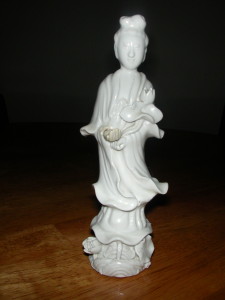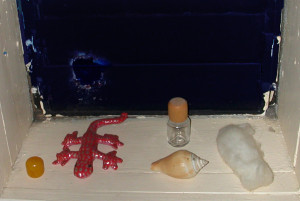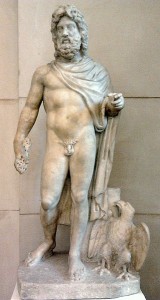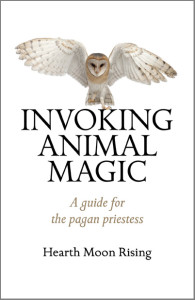 This is the statue of the goddess Kwan Yin which I have on my altar. It was given to me by a student after my first Kwan Yin statue was broken by my cat – not Samhain, the cat I had before her, Misha.I was very grieved by the loss of this statue, not only because Kwan Yin is an important goddess to me, but because the statue was given to me by a good friend I had lost touch with. Someone explained to me, however, that porcelain statues of Kwan Yin are expected to break eventually, and that I should take the statue to a temple rather than dispose of it myself.Knowing how devastated I was by these events, one of my students was excited to find a statue she thought was Kwan Yin at a garage sale. “I don’t know if this is Kwan Yin but I thought it might be,” she said. “But there’s a hole in it where one of the hands should be. We’ve been trying to figure out what that’s for.” I knew exactly what the hole was for, because my first statue had the same feature. The hole is for a detachable hand that is removed from the statue when making a request. The supplicant carries the hand around with her until the prayer is granted, then returns it to the goddess.Kwan Yin is the Chinese Buddhist goddess of mercy, “She who hears the cries of the world.” She is a complex and multifaceted goddess who has been the subject of much scholarship, particularly with the rebirth of the Goddess Movement. Even before this she had a sizable devoted following, among Westerners as well as Chinese. I first heard about Kwan Yin at a lecture given by the editor of a paper I worked on, Libby Gregory. In the dark ages before videos and the Internet, Midwesterners went to lectures for entertainment. I don’t know if it was a product of the big tent Christian revival experiences of the audience or if this is a common experience during discussions of Kwan Yin, but after Libby’s talk many people came forward and shared their miraculous experiences with Kwan Yin’s intervention. I was impressed.Because she introduced me to Kwan Yin, my feelings about this goddess are intertwined with my feelings about Libby. A small business owner and editor of the local left-wing paper, Libby was a driving force behind the progressive movement in our conservative town. To be honest I often thought of her as a bit of a nuisance, frequently calling me on the telephone requesting my services for hard journalistic assignments requiring a great deal of investigation. For some reason I almost always said yes, even though these assignments offered very little pay. It was another Kwan Yin miracle.Eventually I moved away to the West Coast and didn’t think too much about Libby. I liked her, but I certainly didn’t give her my new phone number. It was when I was back for one of my infrequent visits that I learned Libby had died several years earlier, killed in a plane crash. Although Libby had never been a huge figure in my personal life, I could not imagine the town without her. She was like the Olentangy River or the state university campus – she was a part of the community structure. Her loss left a hole that could not be replaced.It did not surprise me to learn that “killed in a plane crash” only told part of the story. Libby had stayed behind to help other passengers as the smoking plane was being evacuated, and so was one of the few who did not survive. We could wish she had left the burning aircraft while she had a chance, but if she had done that she wouldn’t have been the person she was.When I was ordained in the Fellowship of Isis, I was asked to make a pledge to three goddesses, one of which I would be “priestess of” and two more I would agree to serve. I chose Kwan Yin as one of my three goddesses. Not because of Libby exactly, but because of mercy.My student took the statue back home and asked her woodworking husband to make a new hand for it. I’ve always wondered about the missing hand, if someone prayed for something they wanted very much and the request was never granted. I hope by this time they have found recompense for their loss.
This is the statue of the goddess Kwan Yin which I have on my altar. It was given to me by a student after my first Kwan Yin statue was broken by my cat – not Samhain, the cat I had before her, Misha.I was very grieved by the loss of this statue, not only because Kwan Yin is an important goddess to me, but because the statue was given to me by a good friend I had lost touch with. Someone explained to me, however, that porcelain statues of Kwan Yin are expected to break eventually, and that I should take the statue to a temple rather than dispose of it myself.Knowing how devastated I was by these events, one of my students was excited to find a statue she thought was Kwan Yin at a garage sale. “I don’t know if this is Kwan Yin but I thought it might be,” she said. “But there’s a hole in it where one of the hands should be. We’ve been trying to figure out what that’s for.” I knew exactly what the hole was for, because my first statue had the same feature. The hole is for a detachable hand that is removed from the statue when making a request. The supplicant carries the hand around with her until the prayer is granted, then returns it to the goddess.Kwan Yin is the Chinese Buddhist goddess of mercy, “She who hears the cries of the world.” She is a complex and multifaceted goddess who has been the subject of much scholarship, particularly with the rebirth of the Goddess Movement. Even before this she had a sizable devoted following, among Westerners as well as Chinese. I first heard about Kwan Yin at a lecture given by the editor of a paper I worked on, Libby Gregory. In the dark ages before videos and the Internet, Midwesterners went to lectures for entertainment. I don’t know if it was a product of the big tent Christian revival experiences of the audience or if this is a common experience during discussions of Kwan Yin, but after Libby’s talk many people came forward and shared their miraculous experiences with Kwan Yin’s intervention. I was impressed.Because she introduced me to Kwan Yin, my feelings about this goddess are intertwined with my feelings about Libby. A small business owner and editor of the local left-wing paper, Libby was a driving force behind the progressive movement in our conservative town. To be honest I often thought of her as a bit of a nuisance, frequently calling me on the telephone requesting my services for hard journalistic assignments requiring a great deal of investigation. For some reason I almost always said yes, even though these assignments offered very little pay. It was another Kwan Yin miracle.Eventually I moved away to the West Coast and didn’t think too much about Libby. I liked her, but I certainly didn’t give her my new phone number. It was when I was back for one of my infrequent visits that I learned Libby had died several years earlier, killed in a plane crash. Although Libby had never been a huge figure in my personal life, I could not imagine the town without her. She was like the Olentangy River or the state university campus – she was a part of the community structure. Her loss left a hole that could not be replaced.It did not surprise me to learn that “killed in a plane crash” only told part of the story. Libby had stayed behind to help other passengers as the smoking plane was being evacuated, and so was one of the few who did not survive. We could wish she had left the burning aircraft while she had a chance, but if she had done that she wouldn’t have been the person she was.When I was ordained in the Fellowship of Isis, I was asked to make a pledge to three goddesses, one of which I would be “priestess of” and two more I would agree to serve. I chose Kwan Yin as one of my three goddesses. Not because of Libby exactly, but because of mercy.My student took the statue back home and asked her woodworking husband to make a new hand for it. I’ve always wondered about the missing hand, if someone prayed for something they wanted very much and the request was never granted. I hope by this time they have found recompense for their loss.
Month: May 2013
The Messages of Birds
May 27, 2013 Recognizing the signs of birds is one of the most ancient sciences. Another post at Return to Mago blog.
Recognizing the signs of birds is one of the most ancient sciences. Another post at Return to Mago blog.
Kitten
May 24, 2013



Z Budapest – Spell to still the winds
May 22, 2013The Jupiter Stone
May 17, 2013 The god Jupiter has occasionally appeared to me over the years, and I have found his presence surprising for two reasons. The first is that he surely understands that I am a feminist, and a Dianic at that, and am therefore rather miffed about the role his cult has played in the suppression of matrifocal religion. The second thing that has surprised me is that Jupiter’s energy has not seemed offensive and thuggish. He looks stocky and muscular, with an impressive amount of hair and beard, but his energy feels solid yet gentle.Jupiter is considered the Roman equivalent of the Greek god Zeus, the father god of the thunderbolt, who rules the pantheon. He is also the namesake for the large red planet, considered in astrology the planet of good fortune. Some scholars say that the Indo-European Roman Jupiter became merged with Zeus due to Greek influence in late classical times. Others say that an Etruscan god Tinia, who may himself have been drawn from Greek influence, became merged with the Roman Jupiter. Still others say that both Jupiter and Zeus are forms of a proto-Indo-European supreme sky father deity. An alternate idea is that a pre-Indo-European god of unknown name became merged with Jupiter after Indo-European conquest. None of these hypotheses are exclusionary: a proto-Indo-European Sky Father may have merged with prominent local gods in the Greek and Roman peninsulas, later becoming merged again, with another god Tinia thrown into the mix during a period of Etruscan influence.There is not much written for the lay reader on the earliest form of Jupiter. Most people simply do not find early Roman religion very interesting. We do know that his earliest known shrine was southeast of Rome and pre-dated Rome, and that a confederation from the Latin cities convened there for ceremony twice a year. Stewart Perowne says of Jupiter’s temple in Rome, “It is rather a shock to find that he was neither godlike nor human: he was just an old stone, Jupiter Lapis.” But now my interest is piqued. Here we have the material connection, the fundamental source in nature.Jupiter Lapis “the old stone” oversaw both individual oaths and the ratification of treaties. Perowne asserts that this “goes back to the neolithic days, perhaps even before them . . . When the metal-users arrived they associated these venerable and rather terrifying flints with the greatest deity they knew, the god of light, Jupiter, who among other functions was the punisher of perjurors.”
The god Jupiter has occasionally appeared to me over the years, and I have found his presence surprising for two reasons. The first is that he surely understands that I am a feminist, and a Dianic at that, and am therefore rather miffed about the role his cult has played in the suppression of matrifocal religion. The second thing that has surprised me is that Jupiter’s energy has not seemed offensive and thuggish. He looks stocky and muscular, with an impressive amount of hair and beard, but his energy feels solid yet gentle.Jupiter is considered the Roman equivalent of the Greek god Zeus, the father god of the thunderbolt, who rules the pantheon. He is also the namesake for the large red planet, considered in astrology the planet of good fortune. Some scholars say that the Indo-European Roman Jupiter became merged with Zeus due to Greek influence in late classical times. Others say that an Etruscan god Tinia, who may himself have been drawn from Greek influence, became merged with the Roman Jupiter. Still others say that both Jupiter and Zeus are forms of a proto-Indo-European supreme sky father deity. An alternate idea is that a pre-Indo-European god of unknown name became merged with Jupiter after Indo-European conquest. None of these hypotheses are exclusionary: a proto-Indo-European Sky Father may have merged with prominent local gods in the Greek and Roman peninsulas, later becoming merged again, with another god Tinia thrown into the mix during a period of Etruscan influence.There is not much written for the lay reader on the earliest form of Jupiter. Most people simply do not find early Roman religion very interesting. We do know that his earliest known shrine was southeast of Rome and pre-dated Rome, and that a confederation from the Latin cities convened there for ceremony twice a year. Stewart Perowne says of Jupiter’s temple in Rome, “It is rather a shock to find that he was neither godlike nor human: he was just an old stone, Jupiter Lapis.” But now my interest is piqued. Here we have the material connection, the fundamental source in nature.Jupiter Lapis “the old stone” oversaw both individual oaths and the ratification of treaties. Perowne asserts that this “goes back to the neolithic days, perhaps even before them . . . When the metal-users arrived they associated these venerable and rather terrifying flints with the greatest deity they knew, the god of light, Jupiter, who among other functions was the punisher of perjurors.”
REVIEW Jezebel: The Untold Story of the Bible’s Harlot Queen by Lesley Hazelton
May 10, 2013 Just as there is an aphorism that “the victors write history,” there is another that says “history is continually rewritten.” Both of these sayings apply to this rehabilitation of the biblical queen. Hazelton views Jezebel’s story as an earlier version of tensions between liberalism and religious zealotry, drawing direct parallels to present day conundrums over Christian, Jewish, and Muslim fundamentalism. Hazelton’s prose is spellbinding, and though the book does not read like a novel, the story is riveting all the same. Rhetorical asides are satisfying and engrossing. There are many good, satisfying quotes from this book:
Just as there is an aphorism that “the victors write history,” there is another that says “history is continually rewritten.” Both of these sayings apply to this rehabilitation of the biblical queen. Hazelton views Jezebel’s story as an earlier version of tensions between liberalism and religious zealotry, drawing direct parallels to present day conundrums over Christian, Jewish, and Muslim fundamentalism. Hazelton’s prose is spellbinding, and though the book does not read like a novel, the story is riveting all the same. Rhetorical asides are satisfying and engrossing. There are many good, satisfying quotes from this book:
When your story is written by those in passionate opposition to everything you believe in, it will be, to put it mildly, warped. Everything becomes twisted; every action, every gesture, becomes not only suspect but turned on its head. The wildest rumors are passed off as fact. Inconvenient facts are ignored or edited out, relegated to oblivion, until all we are left with is not a real person but an image, a morality-tale character, which is how Jezebel would become a kind of wicked witch of the east.
The first thing Hazelton does is to dispense with the common portrayal of Jezebel as a sexualized being, a harlot. This was rather disappointing for me, because that was what motivated me to buy the book. I had read in another review that this book challenges the idea of the “sacred prostitute” in ancient Near East religions. I myself have become frustrated with the “sacred prostitute” terminology, having come to the conclusion that expressions of sexuality in ancient religions bears no resemblance to prostitution, sacred or otherwise. The concept of the “sacred prostitute” has long been politically used to denigrate priestess cults, and more recently to glorify prostitution. I would love to see this phrase stricken from our spiritual conversation.But if I hoped to find a more nuanced exploration of feminine sexuality in religion I was disappointed here on many levels. Hazelton begins her dismissal of the harlot angle by expounding on the limitations of nineteenth century archaeologists, always exasperating because at this point I can see clearly where such a setup is heading. After raking the pioneering archaeologists over the coals, she concedes that they did not come up with this sacred prostitute theory out of nowhere, then proceeds to accuse the Greek historian Herodotus of inventing the concept whole cloth. Hazelton’s treatment of this subject exemplifies problems with her narrative found throughout the book: the naïve acceptance of twenty-first century archaeological perspective, which has its own patriarchal biases; the impulse to conflate goddesses along with a generally poor understanding of Semitic polytheistic cultures; and a tendency for her analysis to fall into the very absolutism she decries in the prophets of Israel.But despite the flaws in perspective, I would not write off this book. The political drama surrounding the story is fascinating, and although this is not my forte, it seems that Hazelton has a good grasp of Old Testament history. She has visited most of the places where the action occurs, and her description of the settings adds an immediacy to her account. There is a map in the front of the book which is helpful.In the end I agree with Hazelton’s refusal to examine Jezebel’s life and legacy in sexual terms. The new framing works, at least for now, though perhaps in the future a biographer will dismiss the theme of religious fanaticism as emphatically as Hazelton dismisses the sexual theme. Like many a good myth, the story of Jezebel will probably always be more useful than it is true.
Invoking Animal Magic
May 3, 2013 I am pleased this week to write about my forthcoming book Invoking Animal Magic: A guide for the Pagan priestess. The book reflects my research into the legends and folklore of various animals, as well as my direct experience in ritual and spellcasting. Rather than write an exhaustive encyclopedia of the “meanings” of different animals, I have elected to identify some of the principles of animal magic in Euro-shamanism and discuss them in a general way. The nine animals I have chosen to explore in depth are representative of different types of animals: those that live underground, those that migrate, those that fly, those that hibernate, etc.Nine is the number of pregnancy, and while I have no illusions that a book is anything like a baby, the process of bringing forth a book is like giving birth. The book is something that came from me, but at the same time is not me. I keep thinking about the last lines of Sylvia Plath’s poem “Metaphors”:
I am pleased this week to write about my forthcoming book Invoking Animal Magic: A guide for the Pagan priestess. The book reflects my research into the legends and folklore of various animals, as well as my direct experience in ritual and spellcasting. Rather than write an exhaustive encyclopedia of the “meanings” of different animals, I have elected to identify some of the principles of animal magic in Euro-shamanism and discuss them in a general way. The nine animals I have chosen to explore in depth are representative of different types of animals: those that live underground, those that migrate, those that fly, those that hibernate, etc.Nine is the number of pregnancy, and while I have no illusions that a book is anything like a baby, the process of bringing forth a book is like giving birth. The book is something that came from me, but at the same time is not me. I keep thinking about the last lines of Sylvia Plath’s poem “Metaphors”:
Money’s new-minted in this fat purse.I’m a means, a stage, a cow in calf.I’ve eaten a bag of green apples,Boarded the train there’s no getting off
Yes, the train has left the station. All the revising, the endless fact checking has to come to an end somewhere. Errors in fact and grammar must now stand. Even scarier is the thought that decades later I may disagree with what I’ve written. How much of what I thought twenty years ago is true for me today?But mostly I’m excited about the start of another journey, looking forward to talking to people about my ideas and curious about the direction they will take me and others.The website for Invoking Animal Magic has more information and an excerpt. The book will be available to hold in your hands in a few months. If you live in the UK, you can pre-order on Amazon. You can receive an email when the book is ready for purchase by going to the US Amazon page or leaving your email address under “subscribe” on the Invoking Animal Magic webpage. Even better, ask your local metaphysical store to carry the book. If you are interested in writing a book review from a pdf copy, let me know.Here’s to an intriguing and illuminating adventure!
